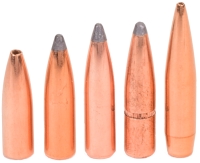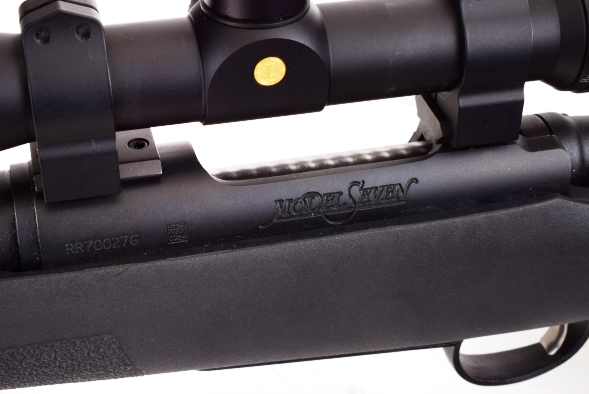
Part II began slowly; coffee, grumbling, lacking in enthusiasm with a high degree of redundancy anticipated, but then the coffee woke me up, research turned up some points of interest and the process became a lot of fun. By the time I got to the shoulder thumping part and pulling numbers off the chronograph, it was a pretty good day.

| Brand | Mfg # | Type | Grains | Length “ | B.C. |
| Sierra Varminter | 1710 | FBHP | 100 | 0.934 | 0.259 |
| Sierra Pro- Hunter | 1720 | FBSP | 120 | 1.082 | 0.356 |
| Nosler Partition | 16320 | FBSP | 125 | 1.175 | 0.449 |
| Hornady Interlock | 2620 | FBSP | 129 | 1.175 | 0.440 |
| Lapua Scenar | 6018 | BTSP | 139 | 1.370 | 0.588 |
The first four bullets are flat base hunting bullets. The first is a fragile jacketed varmint design. The next three flat base soft point designs are suitable for deer size game and, no doubt, Maine size moose. The fifth bullet, a boat tail hollow point, is designed for competitive shooting. The jacket is fragile, the hollow point not intended for controlled expansion on game. The boat tail is intended to reduce base drag, however, it also permits an improved ogive by shifting the bullets weight aft away from the ogive and permitting a more narrow nose. The flat base bullets selected will not perform as well as the boat tail out at 500 yards and beyond, but they are shorter than equivalent boat tail bullets affording greater net case capacity. Inside 300 yards they will fly as good and their construction provides superior terminal ballistics.
Assembly issues?
Issues? I had a few; but then again, too few to mention. I did what I had to do, and saw it through without exemption…. Sorry Frank. The once fired cases were decapped, full length resized, trimmed, cleaned, and primed. The only issue that arose was with the Hornady InterLock bullets. The cannelure was cut too low on the shank for use at a 2.800″ maximum COL.

The round at the far left is a Federal Vital Shok 120 Grain, added to the mix as a point of short barrel velocity comparison. All of the assembled ammunition cleared the Model Seven’s magazine, chambered normally and all bullets cleared rifling. The powder charges were at or near maximum and should not be duplicated without being worked up in a specific firearm. Component selection indicated is what worked best. Any other data was discarded.
 |
Warning: Bullet selections are specific, and loads are not valid with substitutions of different bullets of the same weight. Variations in bullet material and length will alter net case capacity, pressure and velocity results. Primer selection is specific and primer types are not interchangeable. These data represents maximum loads in our firearms and test equipment and may easily be excessive in other applications. All loads should be reduced by 5%, and developed following safe handloading practices as represented in established reloading manuals produced by component manufacturers. Presentation of these loads does not constitute a solicitation for their use, nor a recommendation.
|
||||||||||||||||||||||||||||||||||||||||||||||||||||||||||||||||||||||||||||||||||||||||||||||||||||||||||||||||||||||||||||||||||||
|
|
|||||||||||||||||||||||||||||||||||||||||||||||||||||||||||||||||||||||||||||||||||||||||||||||||||||||||||||||||||||||||||||||||||||
Wrapping it up
The Remington Model Seven is a tight little rifle with good balance, point and track. The fit and finish are quite good and the 260 Remington makes this a good combination. Recoil is there, but moderate, and I get the sense it would take a huge amount of use to show any signs of wear. For the handloader, there is both power and accuracy to be found without a major investment in experimentation. The Model Seven is clearly one of Remington’s better ideas.

Remington’s Model Seven Part I
Remington’s Model Seven Part 11

Email Notification